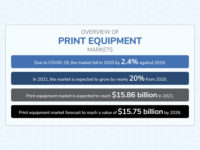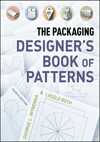Pick your favorite word to describe 2020: challenging, unprecedented, unimaginable, once-in-a-century — you name it — the packaging industry experienced it. Taking a deeper dive, let’s look at how certain segments of the packaging industry fared during the COVID-19 pandemic.
Food & Beverage
The Food & Beverage industry saw dramatic impacts from the pandemic. Meat packing was adversely affected by the pandemic in the short term, resulting in some consumer shortages. At the same time, fast-food outlets saw an increase in demand. Aluminum shortages from the closing of recycling operations and flavoring shortages affected soda companies. From the food services sector, when arenas and sporting venues closed, demand for food packaging declined. As large offices and manufacturing plants closed, company cafeterias likewise were shuttered.
During the lockdown and beyond, vast numbers of consumers turned to online grocery shopping, a trend that undeniably will continue. In 2021, it is estimated that U.S. online grocery sales will make up 12.4% of the country’s e-commerce sales. Another report suggests that the number of U.S. digital grocery buyers will grow from 131.6 million in 2020 to 137.9 million in 2021. That’s 4.8% year-over-year growth.
IMPACT saw the increase in demand firsthand for fast food and consumer beverages as it related to packaging. The folding carton division makes the dies that cut approximately 80% of all fast-food containers and virtually all beer and soda cartons. Recently, one of our customers shipped out 60 truckloads of cartons for medium-sized chicken nuggets in one week.
Automotive
The automotive industry has been hit by the pandemic in a variety of ways. During the height of the pandemic, assembly plants and suppliers in North America closed for about two months from March-May 2020. At the same time, the Big Three auto manufacturers and many suppliers offered parts of their operations to medical device manufacturing.
Moreover, converters in the automotive industry are working on parts for vehicles that will be assembled anywhere from one to three years from now, so the effects of the pandemic may continue to plague the industry for the next few years.
The continuing global semiconductor chip shortage has resulted in acres of fully assembled vehicles waiting for the chips to power the electronics. Goldman Sachs forecasts a continuing shortfall of components that make up semiconductor chips until at least the end of 2021 and into 2022.
Medical
The medical device and life sciences industry saw a significant uptick, with demand soaring for PPE, face masks for the medical and consumer markets, gauze, bandages, wound products, surgical sponges and similar products.
An interesting phenomenon occurred with some automotive OEMs and their suppliers producing medical devices during the height of the pandemic in 2020, including ventilators and face shields, and now continuing to pivot to medical industry needs as the chip shortage threatens to idle plants. For example, plants using extruders or presses to cut plastic or rubber can cut similar items for different applications in the medical industry.
The Packaging Industry as a Whole
Consumer habits changed significantly during the pandemic, affecting the packaging industry. Home delivery of food and consumer products increased demand for packaging containers and the cartons they are sold or shipped in, including the ubiquitous Amazon carton. The e-commerce side of consumer products exploded.
Before the pandemic, some manufacturers were exploring “ships in own container” (SIOC) options. It relates to finding ways of optimizing products for e-commerce rather than for a brick-and-mortar retail shelf or food service. Experts predict that producers in the near future will aim to optimize packaging for specific channels rather than one-package-fits all.
During the pandemic, various industries were considered essential and were never locked down, including the packaging industry, food & beverage and medical, maintaining demand for packaging and tool & die components. In mid-April of 2020, the packaging industry continued to operate at between 83-95% capacity.
The main drivers during the pandemic, according to a report from Markets and Markets, “include the increased demand for ‘fast-moving consumer goods’ (FMCG), pharmaceutical packaging and rising e-commerce sales due to the lockdown.” We know that e-commerce and home online shopping are here to stay.
With the pandemic, we’ve seen a decrease in new products and new product innovations as industry sectors work to meet current demand. For example, end customers in the consumer product goods industry are focused on maintaining supply levels to grocery and big box stores and are not looking at new packaging designs. Converters and manufacturers are replacing old equipment with new equipment or ordering new equipment as backups to avoid potential disruptions.
Similarly, we’re seeing a simplification of product offerings based on stock keeping units or SKUs across industries — called SKU optimization or SKU rationalization. An article in Consumer Goods Technology reported that during the pandemic, big names like Mondelez International, General Mills, Procter & Gamble and Coca-Cola focused more on core brands, streamlining offerings and in some cases, discontinuing certain SKU categories.
Take the example of potato chips; according to a recent article in Forbes, PepsiCo’s Frito-Lay subsidiary stopped producing a fifth of its products during the pandemic, including lightly salted Lay’s potato chips. The company expects the Frito-Lay snacks business to include 3-5% fewer products as the pandemic wanes.
For a company like IMPACT and many other enterprises, diversification has been a key to success. An increase in the demand for tool & die solutions in the medical industry countered a decrease in the demand in the automotive sector. By offering steel rule dies, flexible and solid rotary dies and the custom solutions for converters and manufacturers to fit their requirements, IMPACT helped its packaging customers survive and thrive during the pandemic.
For more information, visit www.impactcss.com.







